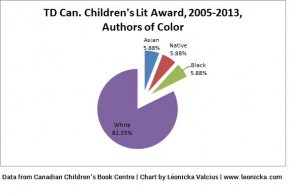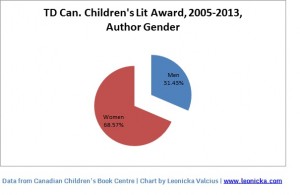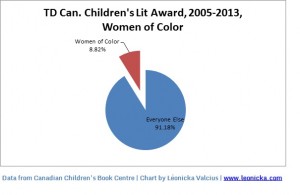I often rely on anecdotal information when I speak about the lack of diversity in Canadian publishing. I’ll talk about the demographics of my publishing class, my difficulty finding diverse books on shelves, and compare the number of books about black children to the number of books about dinosaurs. However the work by Cooperative Children’s Book Center, Canadian Women in the Literary Arts, Lee and Low, and Diversity in YA, has inspired me to attempt to gather hard data about the state of the Canadian publishing industry.
Since Fall is book award season, I’m going to take a look at the diversity of the nominees. Book awards are important because they indicate which books and authors we deem worthy of praise. Canadian publishing often escapes scrutiny because it is eclipsed by the US and UK in conversations about English-language publishing. Thus the conversations about lack of diversity focus on the US, allowing the Canadian industry to ignore the plank in its eye, so to speak. Specifically, I will start by looking at book awards for children, partly because I work in the Canadian kidlit industry, but mostly because it is my belief that children have extra “gatekeepers” who could potentially limit their access to diverse books. If parents, teachers, librarians, and book buyers rely on awards lists to find “the best books” for kids to read, yet those awards lists are not diverse, Canadian kids may only have access to a narrow selection of books and authors.
About TD Canadian Children’s Literature Award and my methods
“On October 28, 2004 the Canadian Children’s Book Centre and the TD Bank Group announced the establishment of a brand-new annual, children’s book award, the TD Canadian Children’s Literature Award for the most distinguished book of the year. “Distinguished” is defined as marked by conspicuous excellence and/or eminence, individually distinct and noted for significant achievement with excellence in quality.” For more information: http://www.bookcentre.ca/awards/td_canadian_childrens_literature_award
I modeled my research after Malinda Lo‘s methods for the Diversity in YA reports because I found them simple and accessible. I did make a few adjustments for my own needs. I am only looking at authors, not characters or content. Discussions regarding diverse content are easily derailed (“Writing about people of color is so hard!” “But she really IS sassy with chocolatey skin!”) and ignore the fact that we can’t have diverse content without first having diverse content-creators.
Because the award was established so recently I was able to look at all the nominees to date. There are five English-language nominees every year, (except in 2006 when there were only four) for a total of 44 nominees. Of those 44 nominees, I only counted each author once for a total of 35 unique authors.
It is important to note that though the award claims to only honor Canadian authors, the fact that both Erin Bow and Christopher Paul Curtis have one seems to suggest that as long as the book is published in Canada, it is eligible. Also worth noting is the large grand prize ($30,000) and the potential for each nominee to also receive a prize.
To avoid getting overwhelmed by the data, I am only looking at gender and race. More comprehensive research is absolutely necessary and it’d be great to see the Canadian Children’s Book Centre, or the Quill and Quire take on the task.
I relied on author bios and pictures to determine race and gender. The raw data can be found here. I encourage you to take a look and point out mistakes if you find them to make sure these results are as accurate as possible.
Results

Notes:
I could not find information about Nancy Hartry’s race or heritage so she was removed from this data set. The chart is based on 34 authors.
Some internet sources say Gordon Lightfoot is Native so I counted him as such, but the information is conflicting.

Note:
This chart includes Nancy Hartry and is based on 35 authors.

Notes:
This chart does not include Nancy Hartry and is based on 34 authors.
Two comments and three questions
Since there are many more awards to look at and since I have made my position abundantly clear, I won’t add a lengthy conclusion here. But I do want to make two points.
First: I included the third chart as a reminder that diversity is complex. While the second chart is encouraging in terms of the representation of women writers in children’s literature, the third chart reveals that the women of color are still largely under-represented in the field.
Second: I found it interesting that many authors were nominated several times. Kenneth Oppel even had two books nominated in the same year. I’ve started looking at other awards as well and the trend is similar. Is the pool of Canadian kidlit authors and illustrators really that small or do juries have favorites that they nominate again and again?
Are these nominees representative of Canadian kidlit? If no, why are the juries missing the mark? If yes, what can we do to make Canadian kidlit more diverse?
Please share your comments below and follow the conversation on Twitter using the #DiverseCanLit tag.


Excellent point re. the lack of Latino representation! According to the Stats Can and this blog post, there are an estimated 500,000 to 700,000 Latinos living in Canada–far less than in the US. However I’m always wary of the using demographics as a benchmark because no country is isolated. Canadian kids know Latino’s exist and should read works about them/by them.
Thanks so much for doing this, Leonika! I know from my experience working on LEE & LOW’s studies that the research takes a loooong time, but being able to point to the numbers really makes a difference in larger diversity discussions.
Looking at your breakdown I noticed there aren’t any Latino authors represented. I don’t know too much about Canadian demographics – is there a signficant Latino population? Are there any Latino-Canadian authors writing/being published? Just wondering.
Hannah
Good point about Erin Bow!
I will be looking at other awards including the GGs, the CLA, and major adult awards. I’ll try to time my posts to coincide with shortlist or winner announcements but it may take me a while to get all the data together.
Will you be analysing other awards too, like the Governor General’s Award and the Sunburst Award? Each province has its own awards too, iirc. If you’re feeling ambitious. No worries otherwise.
Also: Erin Bow is probably a dual citizen. She’s been living in Ontario for more than ten years, so I’d be shocked to learn she hasn’t gotten her citizenship. Christopher Paul Curtis, though… maybe they just decided Detroit was close enough. :)
They’re totally just playing favorites. Every awards committee does it.
Nice Job Leonicka! This data is important when making arguments for self publishing, forming POC alliances, or just disproving the common rhetoric about how much things have changed! Thank you for doing this. Will repost…
-Rob